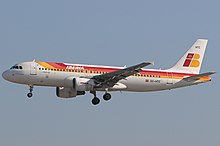 An Iberia
Airbus A320-200 similar to the accident aircraft | |
| Accident | |
|---|---|
| Date | 7 February 2001 |
| Summary | Microburst-induced wind shear, leading to a landing gear collapse and hard landing |
| Site | Bilbao Airport, Spain |
| Aircraft | |
| Aircraft type | Airbus A320-200 |
| Operator | Iberia |
| Registration | EC-HKJ |
| Flight origin | Barcelona-El Prat Airport, Spain |
| Destination | Bilbao Airport, Spain |
| Occupants | 143 |
| Passengers | 136 |
| Crew | 7 |
| Fatalities | 0 |
| Injuries | 25 |
| Survivors | 143 |
Iberia Flight 1456 was a domestic scheduled flight from Barcelona-El Prat Airport to Bilbao Airport, Spain. On Wednesday, February 7, 2001, the Airbus A320 encountered a microburst-induced wind shear on final approach leading to the collapse of the aircraft's landing gear. All 143 passengers onboard survived; with 25 people suffering light injuries, and 1 person receiving serious injuries. The aircraft was irreparably damaged as a result of the ordeal and was decommissioned soon after, making it the ninth loss of an Airbus A320 at that time. This accident prompted Airbus to develop a fail-safe modification for its flight control software by preventing the airplane's built-in protection against stall from being activated by a high rate of change for the angle of attack. [1]
Aircraft
The aircraft was manufactured for Iberia in 2000. It had also made its first flight in 2000. At the time of the accident, it had flown 1,149 hours and 869 cycles. The aircraft was equipped with 2 CFMI CFM56-5B4/P engines. [2]: 5–6
Crew members
There were three cockpit crew and four cabin crew.
Cockpit crew
The captain was a 42-year-old Spanish male who held an Airline Transport Pilot License. He was qualified to fly Airbus A320 aircraft under instrument flight rules (IFR). At the time of the accident, he had a total of 10,805 flight hours. The first officer was a 27-year-old Spanish male who held a Commercial Pilot License. He was qualified to fly Airbus A320 under IFR. At the time of the accident, he had a total of 2,670 flight hours. The trainee pilot, who flew under supervision, was a 24-year-old Spanish male and held a Commercial Pilot License. At the time of the accident, he had a total of 423 flight hours. [2]: 3–4
Cabin crew
There were four flight attendants on the aircraft. [2]: 5
Accident
On Wednesday, February 7, 2001, the Airbus A320 took off from Barcelona-El Prat Airport, Spain. The flight was uneventful until the final approach to Bilbao Airport. The Airbus encountered a microburst-induced wind shear on final approach to the airport. The crew decided to perform a go-around, but the aircraft failed to respond, causing the plane's landing gear to collapse. A subsequent emergency evacuation was carried out. All 143 occupants on the aircraft survived, but 25 people were injured during the evacuation. One crew member and 23 passengers suffered minor injuries, while a female passenger was seriously injured. Seven injured passengers were taken to hospitals. The three pilots were not injured. The aircraft was substantially damaged and written off, making it the ninth hull loss of an Airbus A320. [1] [2]: 2–3
Other damage
The runway received minor damage upon the aircraft's hard landing. Two runway edge lights were broken. [2]: 3
Investigation
The Civil Aviation Accident and Incident Investigation Commission (CIAIAC) immediately launched an investigation into the accident, which took 5 years and 9 months. The investigation by the CIAIAC concluded:
The activation of the angle of attack protection system, which, under a particular combination of vertical gusts and windshear and the simultaneous actions of both crew members on the sidesticks, not considered in the design, prevented the plane from pitching up and flaring during the landing. [1]
Aftermath
This accident prompted Airbus to develop a modification for its flight control software by preventing the airplane's built-in protection against stall from being activated by a high rate of change for the angle of attack. Following this accident, the CIAIAC made four safety recommendations. [3]
References
- ^ a b c Accident description at the Aviation Safety Network. Retrieved on 3 June 2020.
- ^ a b c d e "Final report of EC-HKJ in English" (PDF). Retrieved 3 June 2020.
- ^ "Airbus A320 Accident, Bilbao Airport, Spain, 2001". SkyBary Aero. Retrieved 3 June 2020.
- Aviation accidents and incidents in 2001
- Aviation accidents and incidents in Spain
- Airliner accidents and incidents caused by microbursts
- Airliner accidents and incidents caused by weather
- Accidents and incidents involving the Airbus A320
- Iberia (airline) accidents and incidents
- 2001 in Spain
- February 2001 events in Europe